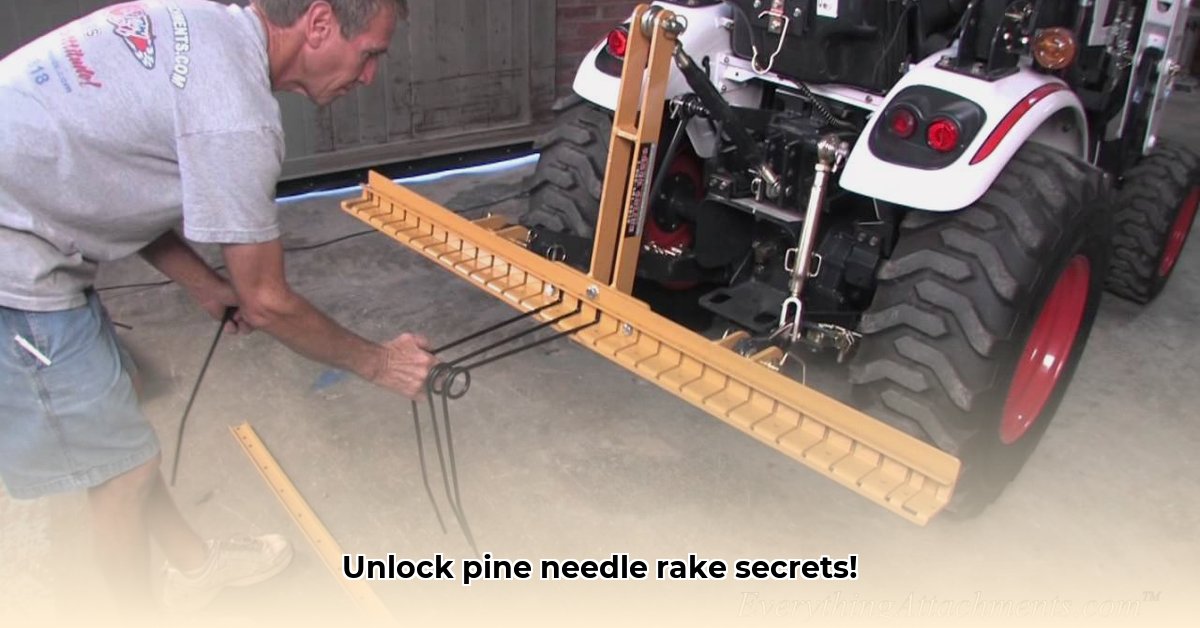
Pine needle accumulation can significantly impact the health and aesthetics of your land. A tractor-mounted rake offers an efficient solution, but choosing and using it correctly is crucial for sustainable land management. This guide provides a step-by-step approach to maximize efficiency and minimize environmental impact. For more detailed information on tractor rakes, check out this helpful resource: Tractor Rake Guide.
Choosing the Right Rake: A Key Decision
Selecting the appropriate rake hinges on several factors: your property size, the density of pine needles, your tractor's horsepower, and your budget. A larger rake covers more ground quickly, but requires a more powerful tractor. Tine material also matters: steel tines are durable but prone to rust, while aluminum tines are lighter and rust-resistant, but potentially less durable. Spring tines offer gentler ground engagement. Isn't understanding these nuances critical to making an informed decision?
The following table compares different rake types:
| Rake Type | Tine Material | Width (feet) | Pros | Cons | Recommended Tractor HP |
|---|---|---|---|---|---|
| Heavy-Duty Steel | Steel | 6-10 (approx.) | Durable, effective in dense debris | Heavy, prone to rust, requires powerful tractor | 30+ |
| Lightweight Aluminum | Aluminum | 4-8 (approx.) | Lightweight, rust-resistant, easier to maneuver | Less durable, may bend with heavy debris | 20+ |
| Spring Tine Rake | Steel/Aluminum | 4-6 (approx.) | Gentler on the ground, reduces turf damage | May not be effective in extremely dense needle areas | 15+ |
Remember: always verify compatibility with your tractor's three-point hitch system and PTO horsepower rating before purchasing.
Operating the Rake: A Step-by-Step Approach
Safe and efficient rake operation involves a few key steps. Always consult your rake's manual for specific instructions. A single mistake could lead to damage or injury, isn't safety paramount in such operations?
Step 1: Safe PTO Engagement. Engage your tractor's PTO only after the rake is securely attached. Disengage the PTO before attaching or detaching the rake.
Step 2: Lowering the Rake. Gradually lower the rake using your tractor's hydraulic controls. Avoid abruptly dropping it.
Step 3: Initial Raking. Start at a slow speed and gradually increase as you become comfortable. Overlapping passes ensures thorough cleaning.
Step 4: Constant Vigilance. Maintain awareness of your surroundings. Avoid any contact with moving parts.
Safety Gear is Essential: Always wear safety glasses, gloves, and sturdy boots. Proper safety precautions are non-negotiable.
Maintenance and Safety: Prolonging Rake Lifespan
Regular maintenance is key to extending the rake's lifespan and ensuring safe operation. After each use:
- Inspect Tines: Check for bends, breaks, or wear.
- Clean Thoroughly: Remove accumulated debris, especially from areas prone to clogging.
- Lubricate Moving Parts: Follow manufacturer's recommendations.
- Store Properly: Keep it in a dry location to prevent rust.
A pre-use checklist should include:
- Tine inspection
- Bolt and connection tightness checks
- Hydraulic fluid level verification
Ignoring these simple steps can lead to costly repairs and safety hazards. "Regular maintenance significantly reduces the risk of equipment failure," notes Dr. Emily Carter, Agricultural Engineer at Purdue University.
Alternative Uses: Value Beyond Cleanup
Don't just discard the collected pine needles. Several eco-friendly options exist:
- Mulch: Excellent natural mulch for gardens and landscaping.
- Compost: Adds organic matter to your compost pile.
- Sale: Potential income source if you have a large volume.
Exploring these avenues not only reduces waste but can also create additional revenue streams. "Diversifying the use of pine needles reduces waste and adds economic value," says John Miller, owner of Miller's Green Landscaping.
Environmental Considerations: A Balanced Approach
Removing pine needles can impact the natural ecosystem. While excessive accumulation harms vegetation, complete removal compromises soil temperature and moisture regulation. A balanced approach is required. Further research is needed to understand long-term impacts in various environments. Does your land management strategy incorporate a sensitivity towards the environmental consequences?
Cost-Benefit Analysis: Weighing Your Options
Consider the total cost of ownership: initial investment, maintenance, fuel, and labor savings. Compare this to the cost of hiring landscaping services. Factor in potential income from selling the collected needles. A thorough cost-benefit analysis ensures you make a financially sound decision.
Conclusion: Sustainable Practices for Healthy Land
A tractor-mounted rake can be a valuable tool for efficient land management, but responsible use is critical. Careful planning, preventative maintenance, and consideration of environmental impacts are paramount for sustainable practices. By implementing this strategy, you contribute to both land efficiency and environmental protection.